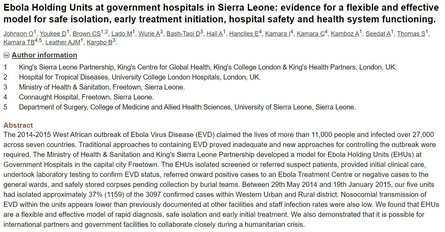
The 2014-2015 West African outbreak of Ebola Virus Disease (EVD) claimed the lives of more than 11,000 people and infected over 27,000 across seven countries. Traditional approaches to containing EVD proved inadequate and new approaches for controlling the outbreak were required. The Ministry of Health & Sanitation and King's Sierra Leone Partnership developed a model for Ebola Holding Units (EHUs) at Government Hospitals in the capital city Freetown. The EHUs isolated screened or referred suspect patients, provided initial clinical care, undertook laboratory testing to confirm EVD status, referred onward positive cases to an Ebola Treatment Centre or negative cases to the general wards, and safely stored corpses pending collection by burial teams. Between 29th May 2014 and 19th January 2015, our five units had isolated approximately 37% (1159) of the 3097 confirmed cases within Western Urban and Rural district. Nosocomial transmission of EVD within the units appears lower than previously documented at other facilities and staff infection rates were also low. We found that EHUs are a flexible and effective model of rapid diagnosis, safe isolation and early initial treatment. We also demonstrated that it is possible for international partners and government facilities to collaborate closely during a humanitarian crisis.